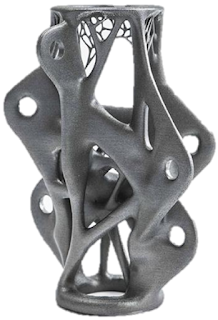Topology Optimisation Workflow
A general workflow is presented in this section to perform a Topology Optimisation (TO) for linear
structural context. Depending for each TO software, the sequence of some steps
can change, but in general, all they should be considered to perform the TO
simulation properly.
1. Geometry selection:
A solid or surface that bounds the region
where the solution must be into. It can be all the model, some body or some
region of the body (Figure 1).
 |
| Figure 1 - Possible geometry selections: (a) solid model, (b) surface model, (c) part of an assembly, (d) region of a part. |
2. Generation of the mesh:
Unless the TO software uses IGA technology, is
necessary to generate the mesh of geometry (Figure 2). Remember that TO is mesh dependent, being influenced by the type, size and order of elements.
 |
| Figure 2 - Mesh of volume boundary. A wide volume was created (green) to allow more freedom to software and to check how could be different the new geometry. |
3. Boundary conditions:
Definition of design region and exclusion
region (Figure 3).
 |
| Figure 3 - Marked with blue, the design region that allows removing material. |
Setting of loadings, supports and
connections (Figure 4).
4. Objectives:
One or more objectives (multiple-objectives)
are defined in this step, different level of weigh of importance can be set if
necessary. The most common objectives of the TO for linear structural are:
- Minimize compliance (simple or multiples loadings)
- Minimize mass
- Minimize volume
- Maximize natural frequencies (one or multiples)
- Maximise buckling loads
5. Responses constraints:
One or more constraints can be defined in
this step, setting a range of values or fixing a value. The most common
constraints of the TO for linear structural are:
- Mass
- Volume
- Global von-Mises stress
- Local von-Mises stress
- Displacement
- Reaction force
- Natural frequency
Typical formulation of Topology Optimisation
Problems (Altair
University, 2015):
- Minimise compliance with constrained mass/volume
- Minimise mass/volume with constrained displacements
- Maximise frequency with constrained mass/volume
- Minimise mass/volume with constrained frequencies
- Minimise combined compliance and frequencies with constrained mass/volume
- Minimise mass/volume with stress constraints
6. Solving:
Set the analysis parameters such as the
number of interactions, convergence accuracy, minimum density, the type of
solver etc. Is important to know the solvers available in the software, and its
better applications and limitations. The most of software allow watching the
interactions of the solution process followed by a graphic or geometry
evolution (Figure 5, Figure 6, Figure 7, Figure 8).
 |
| Figure 5 – Pre-FEM analysis, required to perform the TO next. Equivalent Von-Mises Stress. |
 |
| Figure 6 - Pre-FEM analysis, required to perform the TO next. Total deformation. |
 |
| Figure 7 - The geometry interactions evolutions. |
 |
| Figure 8 - Interactions graphic of TO. |
7. Post-treatment:
Evaluation of the first result and
inspect pseudo nodes. The material can be added or removed through a range of
elements density. The evaluation of the remaining structure get with density
set requires in part, an intuitive judgement of designer and engineers. How
more refined is the mesh, less is the impact of this density setting (Figure 9, Figure 10, Figure 11, Figure 12).
 |
| Figure 9 - All elements density (0 to 1) are shown. |
 |
| Figure 10 - Only elements with density above than 0,5 are shown. |
 |
| Figure 11 - Only elements with density above than 0,7 are shown. |
 |
| Figure 12 - Representation of all material removed from the original volume. |
8. CAD post-treatment:
Geometries created by TO interactions
usually are coarse, and for these cases, CAD post-treatment is required to
smooth the geometry faces, and to produces a practicable body for FEM
simulation. This post-treatment can do with automatics tool available in some
software or manually (Figure 13, Figure 14).
 |
| Figure 13 - The original geometry before treatment. |
 |
| Figure 14 - The final geometry after treatment in CAD environment. |
9. FEM validation:
The final CAD geometry has to be
validated. To avoid extra costs of the project with prototypes and reviews is
recommended first perform a FEM validation (Figure 15).
 |
| Figure 15 - FEM validation of the geometry, using symmetry and convergence test (local refinement). |
10. Results analysis:
The final decision of TO process is if
the final geometry satisfies the project requirements such as cost,
manufacturability, reliability, performance, visual appeal and others tangible
and intangible aspects of the design. The solution found can be reproved, and the
search process will go back to new interactions or approved and go ahead to
next steps to make feasible the commercial production.
Bibliography:
Altair University. (2015).
Practical Aspects of Structural Optimization.



Comments
Post a Comment